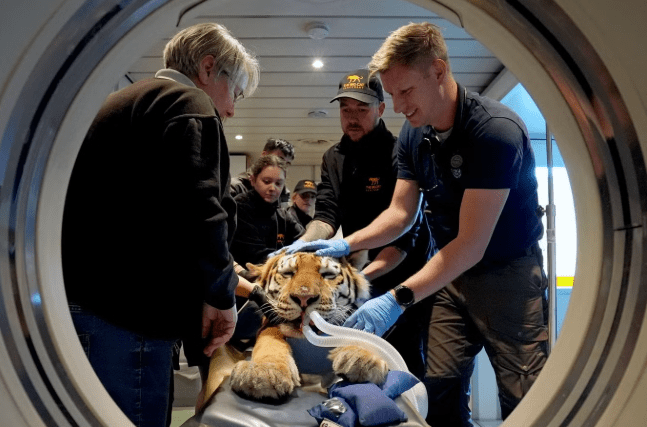Something strange is troubling three majestic residents of a Kent wildlife sanctuary, and experts are racing to find answers.
A tiger, a cheetah and a clouded leopard at The Big Cat Sanctuary in Kent are all suffering from unexplained health problems, described as “mobility issues.” Despite ongoing veterinary attention, the cause behind their discomfort remains a mystery.
CT Scans Used to Uncover Mysterious Big Cat Illness
Earlier this week, the sanctuary enlisted cutting-edge mobile diagnostic tools in hopes of uncovering the source. On Monday, each of the cats was sedated and given a high-resolution CT scan inside a mobile veterinary imaging centre brought directly to the sanctuary grounds.
The trio under investigation includes:
- Luca, a four-year-old Amur tiger
- Django, a ten-year-old mainland clouded leopard
- Mo, a four-year-old Southern African cheetah
All three big cats have displayed unusual difficulties in movement over recent weeks. With no obvious external injuries or prior conditions, the situation prompted the sanctuary’s veterinary team to take a more advanced diagnostic approach.
A vet from the International Zoo Veterinary Group sedated the animals inside their enclosures before carefully transferring them into the mobile scanning unit.
Luca, the Amur tiger, was photographed just before his scan resting with his large paws stretched out and eyes gently closed, clearly in a calm state despite the surrounding activity.
“Ensuring the comfort and safety of our cats is always our top priority, and bringing the mobile CT unit here allowed us to achieve that goal smoothly and efficiently,” Briony Smith, curator at The Big Cat Sanctuary
Expert Collaboration and Cutting-Edge Care
The entire process was part of a carefully coordinated operation between the sanctuary’s staff and veterinary experts.
“The crucial partnership between The Big Cat Sanctuary, our specialist vets Elliot Simpson-Brown and Valerie Freeman, and Burgess Diagnostics has been vital in taking this significant next step towards understanding and resolving the mobility issues for Luca, Django and Mo,” Briony Smith
After the scans, all three cats were gently returned to their respective enclosures while still under anaesthesia. The sedatives were then reversed, and the animals were closely monitored as they recovered.
Specialist veterinary radiographers will now analyse the CT scan data. Their findings are expected in around two weeks. Until then, the sanctuary remains on high alert, continuing its close observation and supportive care for the trio.
“The entire day was a brilliant demonstration of collaborative animal welfare,” Briony Smith
Unusual Case, Even for Wildlife Experts
While minor injuries or health conditions aren’t uncommon in animals under managed care, having three big cats from different species suffer from similar, unexplained mobility issues is raising eyebrows.
Sanctuary staff and veterinary professionals are exploring all possible causes, from neurological conditions and joint disorders to possible environmental factors.
This situation has underscored just how vital technology and teamwork are in modern animal care.
The Big Cat Sanctuary, known for its commitment to conservation and welfare, continues to provide specialised treatment and a calm, supportive environment for its animals. As the investigation unfolds, supporters and wildlife enthusiasts alike are hoping for answers and a swift recovery for the big cats.
Stay tuned to UK News Blog for the latest updates on this developing story from Kent’s Big Cat Sanctuary.






